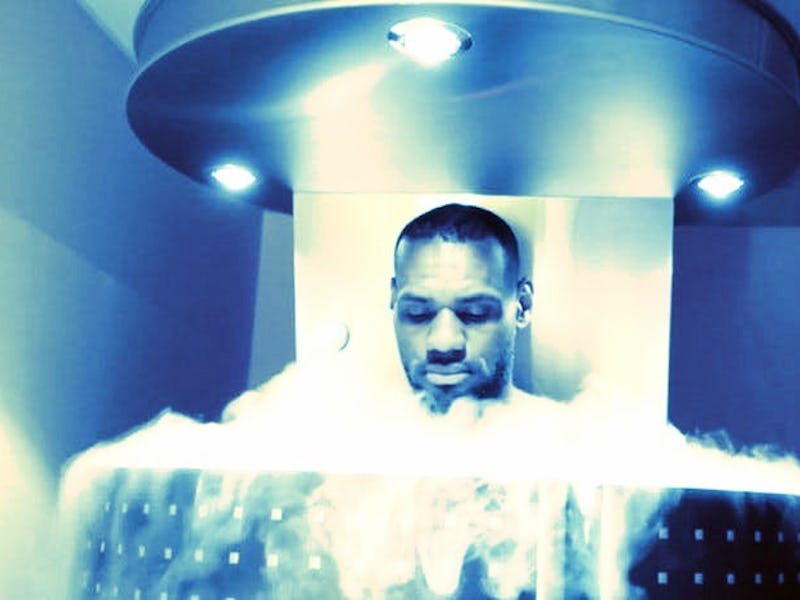What Doctors Want You To Know Before Trying Whole-Body Cryotherapy
Sometimes, all you need is an old-school ice pack.

In May, Golden State Warrior and reigning NBA champ Steph Curry stripped down to his birthday suit, strapped on a weird mask, and stepped into a telephone and stepped into a telephone booth overflowing with thick white fog. He was in a “cryo sauna” filled with liquid nitrogen, which cooled the container to a crisp -264 degrees Fahrenheit.
In whole-body cryotherapy, you’re supposed to chill out in these fridges for three whole minutes, allowing your body to reap the benefits of frigid temperatures. While this may sound like a new form of cruel and unusual punishment, Curry and his fellow elite athletes, like Lebron James and JaVale McGee, have been getting naked and stepping into these cryo saunas to help with healing their overall well-being.
When Curry and McGee invited ESPN to one of their whole-body cryotherapy sessions, McGee explained that he tries to go at least once a week because “it’s 10 times better than an ice tub.”
But Dr. Jennifer Solomon, a specialist in sports medicine and physiatry at the Hospital for Special Surgery in New York City, has yet to warm up to the idea.
“There isn’t much research on [whole body cryotherapy] at all,” Solomon told Inverse. In theory, however, the idea behind this therapy comes from the anti-inflammatory properties of icing.
Ice packs are such an integral part of first aid for muscle injuries requires because they are crucial to stopping inflammation, which is the most immediate and painful response to muscle injury.
When you ice a certain part of the body, vasoconstriction occurs — that’s when blood vessels tighten up — and the blood flow decreases in that area. Doing this ensures you’re “not letting the bad in and then flushing the bad out,” says Solomon, referring to the “bad” chemicals your white blood cells produce in response to a minor injury. These chemicals, while necessary for repair and fighting infection, have the unfortunate side effect of causing the injured area to become swollen and painful.
Cryotherapy takes this concept and pushes it further by “icing” the whole body. In recent years, researchers have investigated whole-body cryotherapy for muscle soreness as well as inflammatory diseases like rheumatoid arthritis. In a study published in 2006 in the journal Clinical and Experimental Rheumatology, researchers compared whole body cryotherapy at two different temperatures (-140 and -230 degrees Fahrenheit) and local cryotherapy on patients with rheumatoid arthritis.
For seven days, study participants would undergo this therapy three times a day. At the end of the week, the researchers saw that the whole body therapy was about the same as the local cryotherapy. Whole body cryotherapy might not be the better option as the researchers pointed out because it is expensive and not widely available at treatment centers. More studies need to be done in the future since the sample size of this study was small—about 20 in each group—and some of the study subjects assigned to do the whole body cryotherapy ended up dropping out of the study.
While there are lots of studies that support traditional icing, “there isn’t enough science behind whole body versus isolated — that’s the bottom line,” says Solomon.
Of course, there are also some risks involved with whole-body cryotherapy, including frostbite, heart attack, and even suffocation. In 2015, a salon worker in Las Vegas was found dead in a cryotherapy chamber: According to the Clark County Coroner’s office, the young woman had suffocated to death due to low oxygen levels in the booth. The liquid nitrogen used to cool the chamber evaporates, and can fill the air; if the chamber is not in a well-ventilated area, eventually the nitrogen gas builds up until there’s no longer enough oxygen in the room. This shouldn’t be an issue, however, as long as there is enough air flow to the room and someone to keep an eye on you.
Still considering a trip to the cryo sauna? “If you’re a healthy person and you want to try it, I think it’s fine,” says Solomon, “but honestly if you’re not healthy, then there are issues.” She recommends anyone with a cardiovascular or neurological issue should avoid whole-body cryotherapy. If you’re determined to try the deep freeze, however, she recommends you consult with your primary care doctor first.